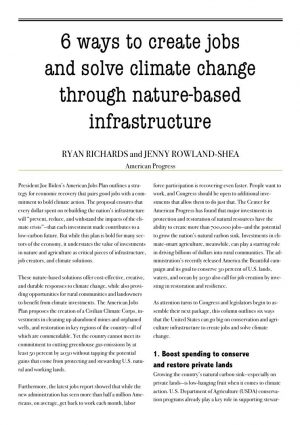 President Joe Biden’s American Jobs Plan outlines a strategy for economic recovery that pairs good jobs with a commitment to bold climate action. The proposal ensures that every dollar spent on rebuilding the nation’s infrastructure will “prevent, reduce, and withstand the impacts of the climate crisis”—that each investment made contributes to a low-carbon future. But while this plan is bold for many sectors of the economy, it understates the value of investments in nature and agriculture as critical pieces of infrastructure, job creators, and climate solutions.
President Joe Biden’s American Jobs Plan outlines a strategy for economic recovery that pairs good jobs with a commitment to bold climate action. The proposal ensures that every dollar spent on rebuilding the nation’s infrastructure will “prevent, reduce, and withstand the impacts of the climate crisis”—that each investment made contributes to a low-carbon future. But while this plan is bold for many sectors of the economy, it understates the value of investments in nature and agriculture as critical pieces of infrastructure, job creators, and climate solutions.
These nature-based solutions offer cost-effective, creative, and durable responses to climate change, while also providing opportunities for rural communities and landowners to benefit from climate investments. The American Jobs Plan proposes the creation of a Civilian Climate Corps, investments in cleaning up abandoned mines and orphaned wells, and restoration in key regions of the country—all of which are commendable. Yet the country cannot meet its commitment to cutting greenhouse gas emissions by at least 50 percent by 2030 without tapping the potential gains that come from protecting and stewarding U.S. natural and working lands.
Furthermore, the latest jobs report showed that while the new administration has seen more than half a million Americans, on average, get back to work each month, labor force participation is recovering even faster. People want to work, and Congress should be open to additional investments that allow them to do just that. The Center for American Progress has found that major investments in protection and restoration of natural resources have the ability to create more than 700,000 jobs—and the potential to grow the nation’s natural carbon sink. Investments in climate-smart agriculture, meanwhile, can play a starring role in driving billions of dollars into rural communities. The administration’s recently released America the Beautiful campaign and its goal to conserve 30 percent of U.S. lands, waters, and ocean by 2030 also call for job creation by investing in restoration and resilience.
As attention turns to Congress and legislators begin to assemble their next package, this column outlines six ways that the United States can go big on conservation and agriculture infrastructure to create jobs and solve climate change.
1. Boost spending to conserve and restore private lands
Growing the country’s natural carbon sink—especially on private lands—is low-hanging fruit when it comes to climate action. U.S. Department of Agriculture (USDA) conservation programs already play a key role in supporting stewardship. For instance, the Conservation Stewardship Program, Environmental Quality Incentives Program, and Regional Conservation Partnership Program all help landowners restore habitat for water and wildlife and manage land to better store carbon and reduce greenhouse gas emissions. Likewise, the Conservation Reserve Program, Forest Legacy Program, and Agricultural Conservation Easement Program protect vulnerable lands from development.
All of these programs are perennially oversubscribed, meaning there is significant unmet demand. And new research finds that, as a result, there are major climate benefits that are currently left on the table. For example, ecologically appropriate reforestation is possible on more than 100 million acres of private forest land, especially in the eastern United States. Investments in smart, environmentally sound reforestation on these lands could sequester hundreds of millions of tons of carbon.
USDA conservation programs deserve a major boost of funding‚ at the very least doubling to meet demand and turn the potential climate benefits of agricultural lands into reality. But Congress should also take this opportunity to create other avenues to support conservation and restoration on private lands, such as tax incentives for restoration and new easement options to keep private forests standing. Conservation and stewardship of private lands should be a high priority—for supporting rural communities, sequestering carbon, and safeguarding the nation’s wildlife.
2. Invest in restoring U.S. public lands
Millions of acres of forests and other habitats on national public lands are in need of restoration. The footprint of past decisions to log, build roads, and stifle normal fire patterns have left the country with ecosystems that are out of sync with their historical condition. And for years, agencies such as the U.S. Forest Service have had to play catch up, shifting staff toward wildfire response ahead of other priorities.
While the 2018 wildfire funding fix helped manage the growing cost of fighting wildfire, agencies need support to complete work that has been put off for too long. Investments in restoration—through prescribed fire, stream restoration, and the removal of unneeded roads—would improve wildlife habitat, protect drinking water, and reduce the likelihood of catastrophic wildfire. These types of investments also help ecosystems store more carbon and stay resilient to a changing climate.
The American Jobs Plan cites these types of investments as a clear opportunity to create good-paying jobs, calling out a model of grant funding laid out in Sen. Michael Bennet’s (D-CO) Outdoor Restoration Force Act. But the scale of need on the ground calls for greater ambition. The Outdoor Restoration Partnership Act—a more recent version of Sen. Bennet’s legislation that has received bipartisan support—does just that, making more than $60 billion in funding available for restoration projects that help states, tribes, and federal agencies create more than 2 million jobs.
3. Protect the Arctic Refuge
In December 2017, the Tax Cuts and Jobs Act opened the coastal plain of the Arctic National Wildlife Refuge to drilling despite the climate and conservation consequences. Then, in January 2021, the U.S. Bureau of Land Management held a lease sale in the area, which returned only $14 million in bids but leased more than 500,000 acres to the oil industry. In his first days in office, President Biden temporarily paused all oil and gas activity in the Arctic Refuge; but with leases already issued and another mandated lease sale on the horizon, Congress should take legislative action now to restore protections for the coastal plain.
The Arctic Refuge is a key piece of carbon-sink infrastructure, and the United States simply cannot achieve its carbon reduction goals if it is drilled for oil.
4. Fix county payment programs
Protected public lands will be central to meeting climate goals, as they anchor the country’s natural carbon sink and sustain healthy rural economies. Unfortunately, existing fiscal relationships between public lands and local governments often run counter to the conservation, restoration, and recreation uses of public lands, even when there are clear long-term benefits. For example, several programs compensate counties for the nontaxable status of federal lands by sharing receipts from commercial activities, such as timber sales, directly with local governments or by making payments that must be appropriated annually. These revenue-sharing payments are often used to support public services but tie local government budgets to extractive commercial activities on public land. By comparison, beneficial activities such as forest restoration, which reduces wildfire risk and creates jobs, fail to support local schools and public services.
The fiscal relationship between public lands and local governments must be updated to reflect the current economic values of these lands, including growing restoration and recreation economies. And payments must be permanent and predictable for counties. Proposals to realign payments with the changing economy include the Section 605 payments being defined by the U.S. Department of the Treasury, as well as potential reforms to the Payments in Lieu of Taxes (PILT) program that would add a “bonus” for public lands dedicated to conservation and recreation uses.
These reforms would allow communities to build economies around multiple values of public lands. Securing permanent and predictable funding will require a new framework for saving and investing receipts—as proposed by S. 1643, which would create a permanent endowment to fund the Secure Rural Schools and Community Self-Determination Act—as well as mandatory funding for PILT.
5. Enact federal oil and gas leasing and fiscal reforms
The federal oil and gas program is broken; it jeopardizes the health of U.S. public lands, does not account for climate change, is an impediment to necessary energy transitions, and is essentially a subsidy for the oil industry. Further, states and communities where leasing occurs have become specialized and overly dependent on continued drilling, leaving them exposed to acute fiscal and economic crises.
The administration’s ongoing leasing pause and program review provides time to reform the leasing process so that it can address pressing climate, economic, and fiscal challenges. Congress is eying a number of reforms of its own to address low royalty rates, low rents and minimum bids, speculative leasing, and bonding and reclamation. Other potential reforms include policies to end noncompetitive leasing, account for the costs of carbon pollution associated with the extraction and burning of fossil fuels, and improve data collection and transparency, including by tracking the costs associated with administering a lease.
In addition, solutions are needed to resolve state and local revenue dependence through opportunities for energy-producing states to separate their budgets from oil and gas development on public lands, while also providing states with financial stability for schools, health care, and other essential services. Any investments in oil and gas reforms should take into account findings from the administration’s assessment of the federal oil and gas program, as well as the ensuing report, which is expected this summer.
6. Expand on what is already in the American Jobs Plan
The American Jobs Plan starts to get at nature-based infrastructure in its proposals for plugging orphaned wells, reclaiming abandoned mine lands, and creating a Civilian Climate Corps. These types of programs are exactly what is needed, but Congress should be even more ambitious.
The plan directs $10 billion to the creation of a Civilian Climate Corps, which would mobilize a new generation of workers to advance conservation, resilience, and environmental justice. There are currently many civilian climate and conservation corps bills introduced in Congress that cover a wide array of landscapes, projects, and challenges. Now is the time to be bold and scale up investments in a 21st century corps that creates jobs and tackles land and water conservation, climate resilience, fire preparedness, and more in both urban and rural areas across the nation.
Abandoned mines and orphaned wells have long damaged the surrounding environment and threatened the public health of communities nearby. The American Jobs Plan’s $16 billion proposal to plug and remediate them is a great start and has the ability to create tens of thousands of jobs each year. However, to ensure that future reclamation costs do not fall on taxpayers and that the fund is not simply an industry bailout, Congress should also assess a reclamation fee on ongoing hard-rock mining operations on federal lands and increase oil and gas bonding rates, as proposed in the Orphaned Wells Cleanup and Jobs Act from Rep. Teresa Leger Fernández (D-NM).
Conclusion
The country needs a rescue package, and the American Jobs Plan provides a valuable blueprint for creating jobs and addressing the climate crisis. Stronger investments in conservation and agriculture infrastructure will only boost those efforts to truly build back better.
Ryan Richards is a senior policy analyst for Public Lands at the Center for American Progress. Jenny Rowland-Shea is the deputy director for Public Lands at the Center.
The authors would like to thank Mark Haggerty and Steve Bonitatibus for their contributions to this column.
Originally published
by Centre for American Progress
May 19, 2021





